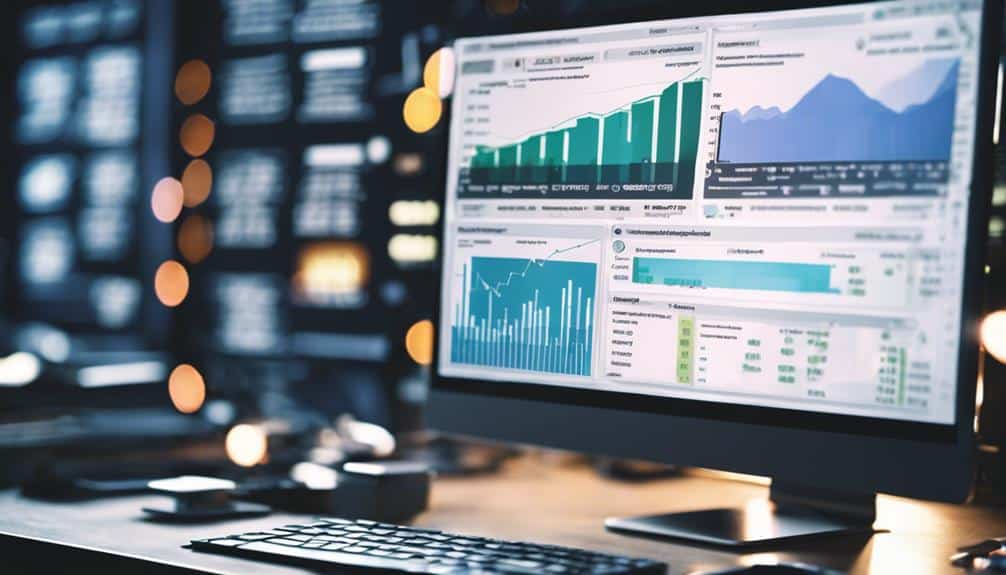When embarking on a project, selecting the best tools for monitoring and control is crucial for success.
Network Diagrams, Critical Path Method (CPM), and Gantt Chart are three stellar instruments that pave the way for effective project management.
But how do these tools truly transform the project landscape, and what unique benefits do they offer?
Let's unravel the intricacies of these tools and discover how they can elevate your project management prowess to new heights.
Key Takeaways
- Network diagrams optimize workflow efficiency and track progress effectively.
- Critical Path Method tool identifies critical tasks and aids in resource allocation.
- Both tools ensure timely project completion by focusing on critical activities.
- Gantt chart software visualizes project schedules and assists in effective progress tracking.
Network Diagrams for Monitoring
Utilize network diagrams as critical tools in project management to visually represent task dependencies and optimize workflow efficiency. These diagrams play a pivotal role in project workflows by illustrating the relationships between tasks and highlighting key milestones. Understanding task dependencies is crucial for determining critical paths, which are the sequences of tasks that directly impact the project schedule.
By monitoring network diagrams regularly, you can track progress, identify bottlenecks, and ensure that project activities are on track for timely completion.
Network diagrams provide a structured approach to project control, allowing you to visualize the flow of activities and make informed decisions to keep the project on course. By utilizing these diagrams, project managers can effectively monitor project schedules, allocate resources efficiently, and anticipate any potential delays.
The ability to monitor and control project activities through network diagrams is essential for achieving successful project outcomes.
Critical Path Method (CPM) Tool
Network diagrams serve as foundational tools in project management, and when it comes to optimizing project schedules and identifying critical tasks, the Critical Path Method (CPM) tool becomes indispensable. CPM is a project management technique crucial for determining the longest sequence of dependent tasks, aiding in establishing the shortest possible project duration. By highlighting tasks that are critical and cannot be delayed without impacting the project timeline, CPM enables efficient resource allocation and precise scheduling to ensure timely project completion. Project managers leverage CPM to concentrate on critical activities, mitigating the risk of delays and ensuring project deadlines are met. Below is a table outlining the key features of the Critical Path Method (CPM) tool:
| Key Features of CPM Tool | |
|---|---|
| Identifies Critical Tasks | ✔ |
| Determines Project Duration | ✔ |
| Aids in Resource Allocation | ✔ |
| Ensures Timely Project Completion | ✔ |
| Focuses on Critical Activities | ✔ |
Gantt Chart Software
Gantt chart software plays a pivotal role in visually representing project schedules and task dependencies, aiding in effective progress tracking and resource management. These tools, such as Microsoft Project, Asana, and Smartsheet, offer customizable features that assist in project management by setting milestones, allocating timeframes, and monitoring project timelines.
By utilizing Gantt charts, project managers can plan, prioritize, and execute tasks efficiently. The software provides comprehensive task management features that allow for the seamless organization of work activities. Project monitoring becomes more streamlined with the use of Gantt chart software, as it enables users to easily track project progress and identify critical paths.
These planning tools are essential for ensuring that projects stay on schedule and resources are allocated optimally. Incorporating Gantt chart software into project management processes enhances productivity and facilitates better decision-making throughout the project lifecycle.
Frequently Asked Questions
How Do You Monitor and Control a Project?
To monitor and control a project effectively, you track progress, manage budgets, communicate with teams, mitigate risks, prioritize tasks, engage stakeholders, evaluate performance, allocate resources, resolve issues, and manage time efficiently.
What Are the Top Five 5 Project Management Tools and Describe Each?
To effectively manage your projects, it's crucial to have the right tools. Dive into the top five project management tools: ClickUp for collaboration, Wrike for reporting, Asana for visuals, Trello for simplicity, and Workzone for planning.
Which Is the Best Project Management Tool?
When choosing the best project management tool, consider factors like time tracking, progress tracking, team collaboration, and budget management. ClickUp offers a comprehensive solution with customizable features, automation, and a user-friendly interface for efficient project monitoring and control.
What Is Project Monitoring Tool?
In project monitoring, you track tasks, progress, collaborate with teams, analyze data, evaluate performance, assess risks, allocate resources, monitor communication, track budgets, and engage stakeholders. It ensures project success through meticulous oversight.
Conclusion
In conclusion, utilizing Network Diagrams, Critical Path Method (CPM), and Gantt Chart software is like having a compass, a map, and a watch for your project journey.
These tools guide you through the project landscape, help you navigate challenges, and keep you on track towards your destination.
With these powerful tools at your disposal, you can confidently steer your project towards success with precision and efficiency.





